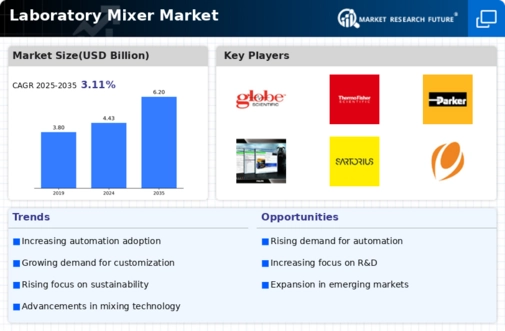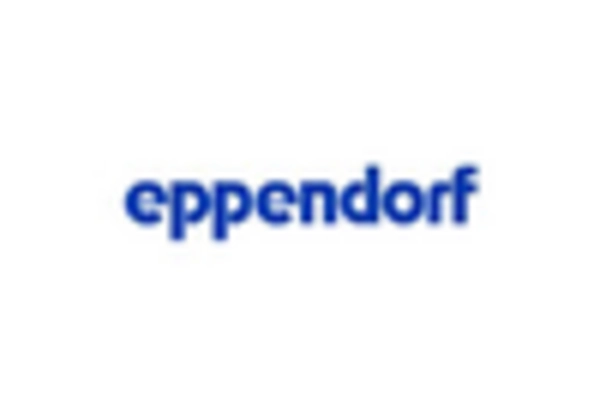Growth in Biotechnology Research
The Laboratory Mixer Market is significantly influenced by the expansion of biotechnology research. As biotechnological advancements continue to evolve, the demand for specialized mixing equipment rises. Laboratory mixers play a crucial role in various biotechnological processes, including cell culture and protein purification. The biotechnology sector is expected to witness a growth rate of around 7% annually, indicating a robust market for laboratory mixers tailored to these applications. This growth is likely to drive innovation in mixer technology, leading to the development of more efficient and versatile mixing solutions. Thus, the Laboratory Mixer Market stands to gain from the increasing investment in biotechnology research and development.
Increased Focus on Quality Control
Quality control remains a critical aspect of laboratory operations, significantly impacting the Laboratory Mixer Market. As industries prioritize product quality and compliance with regulatory standards, the demand for reliable mixing solutions intensifies. Laboratory mixers are essential for ensuring homogeneity in samples, which is vital for accurate testing and analysis. Recent statistics indicate that the quality control market is projected to grow at a rate of 6%, reflecting the heightened emphasis on maintaining high standards in laboratory processes. This trend suggests that the Laboratory Mixer Market will likely see increased investments in advanced mixing technologies that enhance quality assurance protocols.
Rising Demand in Pharmaceutical Sector
The Laboratory Mixer Market experiences a notable surge in demand driven by the pharmaceutical sector. As the industry continues to innovate and expand, the need for efficient mixing solutions becomes paramount. Pharmaceutical companies require precise and consistent mixing for drug formulations, which enhances product quality and efficacy. According to recent data, the pharmaceutical sector is projected to grow at a compound annual growth rate of approximately 5.5% over the next few years. This growth directly correlates with the increasing adoption of advanced laboratory mixers that ensure uniformity in product development. Consequently, the Laboratory Mixer Market is likely to benefit from this trend, as manufacturers strive to meet the evolving needs of pharmaceutical applications.
Emergence of Advanced Mixing Technologies
The Laboratory Mixer Market is witnessing a transformative phase due to the emergence of advanced mixing technologies. Innovations such as automated mixers and smart mixing systems are gaining traction, offering enhanced precision and efficiency. These technologies enable laboratories to achieve consistent results while minimizing human error. The market for automated laboratory equipment is anticipated to grow at a compound annual growth rate of 8%, indicating a strong shift towards automation in laboratory settings. This trend suggests that the Laboratory Mixer Market will benefit from the integration of cutting-edge technologies, leading to improved operational efficiency and productivity.
Expansion of Educational and Research Institutions
The expansion of educational and research institutions plays a pivotal role in shaping the Laboratory Mixer Market. As more institutions invest in research and development, the demand for laboratory equipment, including mixers, is likely to increase. Educational institutions require laboratory mixers for various experiments and research projects, contributing to the overall growth of the market. Recent data indicates that the education sector is expected to grow at a rate of 4.5%, which may lead to increased procurement of laboratory mixers. This trend highlights the potential for the Laboratory Mixer Market to thrive as educational and research institutions continue to expand their capabilities.


















Leave a Comment